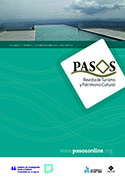Ex Libris Tour: how can emblem books inspire new proposals for literary tourism?
DOI:
https://doi.org/10.25145/j.pasos.2023.21.050Keywords:
Literary destinations, Alternative tourism, Interpretation, Emblem studies, HeritageAbstract
This paper aims at discussing how emblem studies can contribute to creating new literary tourism products, by questioning to what extent the selected places fit into the categories of literary destinations. It proposes drawing differentiated routes across Europe, curated by scientific knowledge, showing the potential of Alciato’s Emblemata (1531) as an inspiring resource for literary tourism. Based on the theoretical research of comparative studies, literary tourism and emblems, this case study shows how the hermeneutic process of decoding meanings can lead people (tourists, guides and stakeholders) to connect with artistic heritage by interpreting its symbolic language and value. The proposal explores a new perspective in literary tourism products through emblem studies, fostering a deeper knowledge of the impact of active reading skills on cultural experiences. It considers that literary expertise encourages people to travel differently and reframes the concept of “emblematic places” on tourist routes.
Downloads
Publication Facts
Reviewer profiles N/A
Author statements
- Academic society
- PASOS. Revista de Turismo y Patrimonio Cultural
- Publisher
- Instituto Universitario de Investigación Social y Turismo. Universidad de La Laguna (España) - Instituto Universitario da Maia ISMAI (Portugal)
References
Bibliography
Abbondanza, R. 1960 “Alciato, Andrea”. Dizionario Biografico degli Italiani, vol. 2, available at: https://www.treccani.it/enciclopedia/andrea-alciato_(Dizionario-Biografico) / (accessed 10 October 2021).
Adams, A., Rawles, S. and Saunders, A. 1999-2002 A bibliography of French emblem books. Geneva: Droz.
Alciato at Glasgow Project, available at: https://www.emblems.arts.gla.ac.uk/alciato (accessed 11 October 2021)
Alciato, A. 1550 Emblemata. Lyon: Macé Bonhomme for Guillaume Rouille.
Alciato, A. 1996 Emblemata, Lyons, 1550. Translated and annotated by Betty I. Knott, with an introduction by John Manning. Aldershot: Scolar Press.
Amaral Jr., R. and Leal, P. 2017 Emblems in Colonial Ibero-America: To the New World on the Ship of Teseus. Glasgow Emblem Studies, 18.
Araújo, F. 2014 Verba significant, res significantur: a receção dos Emblemata de Alciato na produção literária do Barroco em Portugal. Coimbra, Doctoral thesis presented at University of Coimbra, available at: http://hdl.handle.net/10316/26492 (accessed 14 October 2021).
Baleiro, R. and Quinteiro, S. 2018 Key Concepts in Literature and Tourism Studies. Lisbon: University of Lisbon and University of Algarve.
Bath. M. 2018 Emblems in Scotland. Motifs and Meanings. Leiden: Brill/Rodopi.
Bernat, A. and Cull, J. T. 1999 Enciclopedia Akal de Emblemas Españoles Ilustrados. Madrid: Akal.
Campa, P. 1990 Emblemata Hispanica, An Annotated Bibliography of Spanish Emblem Literature to the Year 1700. Durham and London: Duke University Press.
Crang, M. 2011 “Tourist: moving places, becoming tourist, becoming ethnographer”. In Merriman, P. and Cresswell, T. (Eds), Geographies of Mobilities: Practices, Spaces, Subjects (pp. 205-224). London and New York: Routledge.
Daly, P. and Dimler, R. 1997-2007 The Jesuit series. Toronto: University of Toronto Press.
Daly, P. 2016 The Emblem in Early Modern Europe: contributions to the theory of the emblem. London: Routledge.
Gomes, L. 2008 Mosaics of Meaning. Studies in Portuguese Emblematics, Glasgow Emblem Studies, 13.
Green, H. 1872 Andrea Alciati and his Book of Emblems. A Biographical and Bibliographical Study. London: Trübner.
Hart, J. 2011 Literature, theory, history. New York: Palgrave MacMillan.
Herbert, D. 2001 “Literary places, tourism and the heritage experience”. Annals of Tourism Research, 28 (2): 312-333.
Hoepel, I. and McKeown, S. 2017 Emblems and Impact. Von Zentrum und Peripherie der Emblematik. Newcastle upon Tyne: Cambridge Scholars.
Landwehr, J. 1976. French, Italian, Spanish and Portuguese Books of Devices and Emblems 1534-1827. A Bibliography. Utrecht: Haentjens Dekker & Gumbert.
Lanfant, M-F. and Graburn, N. 2016 “International tourism Reconsidered: The Principle of Alternative”. In Smith, V. (Ed.), Tourism Alternatives Potentials and Problems in the Development of Tourism (pp. 88-11). Philadelphia: University of Pennsylvania Press.
Magadán Díaz, M. and Rivas García, J. 2011 Turismo Literario. Oviedo: Septem Ediciones.
Mansfield, C. 2015 Researching Literary Tourism. Plymouth: Shadows Books & Media.
Mendonça, I. 2011 “Emblemas de Alciato na cúpula da igreja de S. Pedro em Elvas”. In Mendonça, I. and Correia, A. (coord.), Actas do 3º Colóquio de Artes Decorativas (pp. 157-164). Lisboa: FRES.
Moura Sobral, L. 2008 “'Occasio' and 'Fortuna' in Portuguese Art of the Renaissance and the Baroque: a Preliminary Investigation”. Glasgow Emblem Studies, 13: 101-124.
Novelli, M. and Benson, A. 2015 “Niche tourism. A way forward to sustainability?”. In Novelli, M. (ed.), Niche Tourism. Contemporary Issues, Trends and Cases (pp. 247-250). Oxford: Elsevier.
Richards, G. 2018 “Cultural tourism: a review of recent research and trends”. Journal of Hospitality and Tourism Management, 36: 12-21.
Sebastián, S. 1982 “La pintura emblemática de la casa del fundador de Tunja”. Goya, 166: 178-183.
Squire, S. J. 1996 “Literary tourism and sustainable tourism: promoting ‘Anne of green gables’ in Prince Edward Island”. Journal of Sustainable Tourism, 4 (3): 119-134.
UNWTO 2017 “Definitions”, Committee on Tourism and Competitiveness, available at: http://cf.cdn.unwto.org/sites/all/files/docpdf/ctcdefinitionsenweb.pdf (accessed 11 October 2021).
UNWTO 2018. Tourism and Culture Synergies. Madrid: UNWTO.
Watson, N.J. 2009 “Introduction”. In Watson, N. (Ed.), Literary Tourism and Nineteenth-Century Culture (pp. 1-12). Basingstoke: Palgrave Macmillan.
Downloads
Published
How to Cite
Issue
Section
License
Copyright (c) 2022 Filipa Medeiros Araújo

This work is licensed under a Creative Commons Attribution-NonCommercial-NoDerivatives 4.0 International License.
I confirm that the work is original (of my/our authorship), and that it will not be submitted to other journals or publications until the final resolution of the review process in PASOS, RTPC.
I authorize the publication of my work by PASOS, PSTN of free and open access in any of the formats that I deem appropriate, for an indefinite period of time and as a non-remunerated collaboration.
Likewise, the author(s) understands that the published work may be linked or deposited on any server or included in other publications (republication), provided that the new place and/or new edition references the original publication and acknowledges the authorship and copyright ownership of PASOS RTPC publications.
Authors understand that a plagiarism-self-plagiarism check will be performed, and the article may be removed at any time from the editorial flow.










